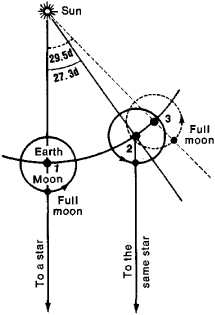month
(redirected from Draconitic month)Also found in: Dictionary, Thesaurus, Legal.
month
month
The period of the Moon's revolution around the Earth with reference to some specified point in the sky (see table). The differences in the monthly periods result from the complicated motion of the moon.Month
an interval of time nearly equal to the period of revolution of the moon about the earth. Different types of months are distinguished (see Table 1 and Figure 1). These include (1) the synodic month, which is the period of the sequence of the lunar phases (it serves as the basis for lunar calendars);
| Table 1. Length of various types of months | |||||
|---|---|---|---|---|---|
| Type of month | Mean solar days | Mean solar time | |||
| Synodic ..... | 29.530588 | 29 days | 12 hr | 44 min | 3 sec |
| Sidereal ..... | 27.321661 | 27 days | 7 hr | 43 min | 12 sec |
| Tropical ..... | 27.321582 | 27 days | 7 hr | 43 min | 4 sec |
| Anomalistic ..... | 27.554550 | 27 days | 13 hr | 18 min | 33 sec |
| Nodical ..... | 27.212220 | 27 days | 5 hr | 5 min | 36 sec |
(2) the sidereal month, during which the moon performs a complete revolution about the earth and returns to its original position relative to the stars; (3) the tropical month, which is the period during which the moon returns to a given longitude; (4) the anomalistic month, which is the interval of time between successive passages of the moon through the perigee; and (5) the nodical month, which is the period of time between successive passages of the moon through the same node of its orbit (this concept is important for the theory of eclipses). In the Gregorian calendar, the year is divided into 12 months, each month containing from 28 to 31 days; this calendar does not agree with the lunar phases.

